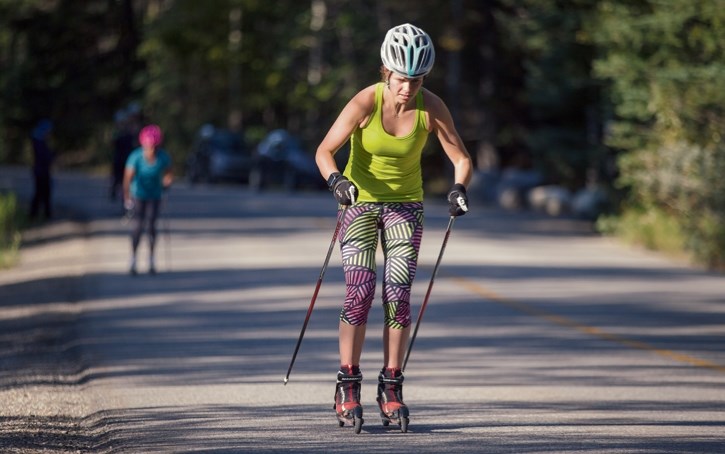Cross-country skier Knute Johnsgaard is collapsed in a heap, frantically trying to catch his breath at the finish line. Rosanna Crawford is wearing her death stare. Another young athlete is on all fours, puking his guts out at the top of Mount Norquay Road.
It’s ‘Testival’ time for Canada’s national team biathletes.
The week-long training block puts the athletes through a series of physical tests bent on pushing their limits in advance of the ski season.
Several cross-country ski teams, including Alberta World Cup Academy, the ParaNordic ski team, and a few national team athletes, joined in for Monday’s (Sept. 5) double pole test up Mount Norquay.
Tuesday brought a three-minute race prologue, followed by a shooting test. Wednesday featured another shooting test, while Thursday saw the team back at Mount Norquay for a skate test. The team finishes with a time trial Friday at the Canmore Nordic Centre. The result is five days of intense testing.
Biathlon Canada coach Matthias Ahrens said Testival works twofold. It provides a condensed block of intensity, and acts as a bench marker for athlete fitness.
“The week-long block simulates a world championship scenario. There are several races in a small time period, and a bit of mental stress of having to perform. Together, the four races together with the shooting test puts a lot of psychological stress on the athletes,” Ahrens said. “It is a bench marker. We do the same battery of tests in the sprint and see how the athletes have moved in their training, and what we can do, what adjustments we can make.”
The event is becoming more popular every year, as more and more teams are challenging themselves against the biathletes. It was no surprise to see Alberta World Cup Academy athletes on the startline after retired biathlete Scott Perras took on assistant coaching duties. Canada’s biathlon team is now a considerable medal threat on the world cup, and provide great competition for any cross-country skier.
“We started out as an internal time trial with the biathlon national team. Shortly after, the development team, the Biathlon Alberta Training Centre, was included. From there, we have included new teams every year,” said Ahrens. “In July, we had the Swiss men join us, and Anais Bescond from France. In the past we had Anna Carin Zidek from the Czech Republic. It’s nice to have that international flair.”
After the first hill climb, Ahrens is happy with what he’s seen from his younger athletes.
Crawford dominated the women’s double pole test, while ParaNordic star Brian McKeever topped the men’s field. It’s his first crack at the test (a blind guy ripping down Mount Norquay road isn’t a good idea, he said) as the ParaNordic team decided to try something new this year.
The two teams shared training time last month during a snow camp in New Zealand, and the bonds seem to have stuck.
“It’s two different sports, but it’s one team. It’s nice to get to know each other a lot better,” McKeever said. “The hill climb is a good test. It’s repeatable, it’s in our back yard. It’s hard. There is no rest in it at all. It’s 20 minutes of putting your head down and suffering, trying to find a rhythm.”
It was also the first time Canadian national cross-country ski team member Dahria Beatty competed in the Mount Norquay Road double pole test. Coming off the biggest training month of her career – clocking 86 hours in August – she wasn’t sure how she would handle the hill climb.
“I was pretty nervous going into it. The double pole test I’ve done in the past is six minutes. I started pretty relaxed, almost zone 2, 3, because I knew it would get really hard, really fast, which it did,” Beatty said.
“My goal was technique-focused and not to fall apart. My tempo was not the highest. For me it was a training race to see what it’s like to double pole a race distance length, because it’s going more and more that way in our sport.”
The Testival is also a good benchmark for younger athletes to see how they measure up against the older team members. Ahrens said it gives them a goal to chase, while Biathlon Alberta Training Centre coach Richard Boruta likes the amount of data he gets from the test of his team.
“It shows the state of training for the athletes. It gives hard data on athletes where they are the moment. It’s a good activity for them in training,” Boruta said. “Some had never seen anything like this. They are shocked at first, but they get used to it.”
The winner of Testival will be crowned Friday at the Canmore Nordic Centre.




